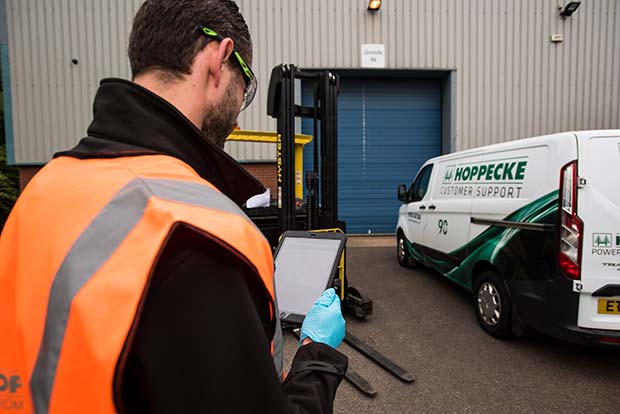Despite the ongoing impact of Covid-19, logistics businesses are working hard to maintain a slick operation capable of adapting to changing circumstances to meet new productivity targets. For managers of materials handling equipment (MHE) keeping costs at bay is always a priority. When you consider that the battery and charger account for 20 to 25 per cent of the cost of a forklift truck, it’s vital to make a sound investment. Gus Whyte, Sales Director-UK and Ireland at Hoppecke Industrial Batteries says the only way to achieve this is by choosing the correct battery and charger for your application’s fleet. Typically, battery capacity is dictated by the equipment supplier. That said, there is almost always a choice, so a clear understanding of the logistics operation is important because choosing the correct capacity affects both the application and initial price.
 Operational impact on battery capacity
Operational impact on battery capacity
There are several ways in which the nature of the logistics operation can affect the decision. To specify battery capacity correctly it’s best to start by assessing hours of use per truck each day and the number of days each truck is in use each week.
Correct chargers
Of course, choice of battery is only part of the equation. Specifying the correct charger is equally important for an appropriate and cost-effective solution. Essentially, it’s a choice between two battery charging technologies. Standard 50Hz chargers are of the transformer type and are unregulated chargers, whereas high frequency chargers are regulated smart chargers.
Generally, both types are readily available with a choice of 12-hour or 8-hour recharge. From less than 80 per cent discharge the time it takes to fully charge may be partially reduced with a 50Hz standard charger. On the other hand, a high frequency smart charger will definitely take less time to achieve the fully charged state because it monitors the battery’s requirements continuously, adjusting its charge profile as necessary during the recharge cycle.
Key charger differences
Initially, a 50Hz charger costs less to purchase but this is perhaps outweighed by the fact that it is larger in size and heavier than its high frequency counterpart. Depending on manufacturer it is also only 60 to 80 per cent efficient. Since the charger controls the battery requirements, higher input amps are also required, and the charger needs a type D slow acting RCD/Fuse.
By comparison, a high frequency charger comes with a higher initial price tag but enjoys lower running costs. Not only is it smaller and lighter, but it is 85 to 95 per cent efficient and there is the added benefit of reduced battery electrolyte filling requirements. A high frequency charger works equally well with either a 50Hz or 60Hz AC supply and is not dependent on a stable mains supply. The battery controls the charger during recharge so lower input amps are required and at Soft Start it works with a standard B or C RCD/Fuse.
Although both types of charger are available in 400v/415v three phase and 230v/250v single phase options, high frequency chargers are designed for European markets. Therefore, they are more common in 48 volt and 80-volt configuration for three phase 400/415-volt supply.
Specifying chargers
The basis for determining the correct charger for any given MHE operation will also depend on the continuous hours available to recharge batteries. Standard lead-acid batteries should receive a full charge plus a minimum cooling time of one hour. Quite simply, a 12-hour charger will need at least 13 hours between battery connection and disconnection.
As a good rule of thumb never choose a charger based solely on current productivity levels. Targets are apt to fluctuate for all sorts of reasons so consider higher future production possibilities. What works perfectly well now with a 12-hour charger is unlikely to meet expectations over a five-year period if business increases.
Electrical supply
If you’re planning to multishift or are concerned about insufficient recharge time, spare batteries or organised opportunity charging could be the answer. The Hoppecke Trak-Air system offers a 5.5-hour recharge, safe opportunity charge or rapid charge solutions, for example. For an efficient and cost- effective solution it’s worth taking the time to discuss the options with your specialist battery partner.
Cold store operations
Operating MHE in cold store areas causes a reduction in lead-acid battery capacity by up to 25 per cent. What’s more, because the low temperature of the electrolyte affects its viscosity during recharge, the battery voltage rises quicker than the specific gravity. As standard 50Hz chargers switch off when voltage is reached, the specific gravity never recovers sufficiently to support the operation. It therefore pays to consider the HF charger option for such applications, preferably in conjunction with a battery-controlled temperature probe, since this will greatly improve the availability of battery capacity.
A number of factors influence the choice of battery and charger, which is why it makes sense to seek expert advice on what is right for your MHE fleet and individual application. Specifying the correct battery and charger is key to making a sound investment that will support productivity over the long term.




Comments are closed.